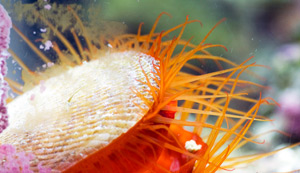Mention beautiful bivalves for the marine aquarium, and the various tridacnid clams (the so-called giant clams) will probably come to mind. Likely, the flame scallops of the genus Ctenoides will too. However, while the tridacnids have a fairly decent survival record in captivity if given proper care and a suitable environment, the flame scallops usually fare dismally in aquariums.
The two usual suspects
Based strictly on my personal observations, the two flame scallops you’re most likely to come across in the aquarium trade are C. Scaber (formerly Lima scabra), found in the Caribbean, and C. ales (formerly Lima ales), also known as the electric or disco flame scallop, from the Indo-Pacific.
They range between 3 and 4 inches in diameter and have white shells and red to orange-red tissues. They also have long, tapering red, or sometimes white, tentacles extending from the mantle. C. ales gets the “electric” or “disco” moniker from the fascinating flashing display it produces on its mantle lip, which looks rather like flickering electricity.
Interestingly, a recent study published in the Journal of the Royal Society (read the report) has revealed that C. ales achieves this flashing effect not via bioluminescence, as once thought, but by reflecting light with tiny silica spheres.
So why shouldn’t I keep one?

These bivalves present a few significant challenges with respect to aquarium keeping. Chief among them are their dietary requirements. Unlike the tridacnid clams and most of the corals we keep in reef systems, the flame scallops are azooxanthellate, meaning they don’t have photosynthetic zooxanthellae in their tissues to help sustain them. Instead, they must get all the nutrition they need from filter-feeding on plankton of very small particle size, e.g., phytoplankton and invertebrate larvae.
Aye, there’s the rub! Even a very mature reef system with a productive refugium attached is unlikely to provide enough plankton to sustain these creatures, so you have to routinely introduce significant quantities of plankton of a suitable particle size to the tank—either by target feeding or flooding the system with enough plankton to produce a sufficient concentration in the water column.
As you can imagine, this feeding approach can quickly foul the tank. What’s more, it’s very difficult to determine whether the scallop is actually ingesting the plankton offered—not to mention getting enough nutrition from the food assuming it is actually ingesting it. The harsh reality is that most specimens starve to death within a matter of months in captivity.
Another issue with these bivalves is that they tend to favor hidden recesses and more subdued lighting. Couple that with their ability to swim (albeit not particularly gracefully) by clapping their shells open and closed, and it shouldn’t be surprising that specimens kept in aquariums often “wander” into regions of the tank where it’s difficult to reach or see them, further complicating feeding.
The bottom line? Despite their gorgeous looks and usually very modest price tag, the flame scallops are best left to very dedicated, expert hobbyists—or better yet, left in the ocean.



